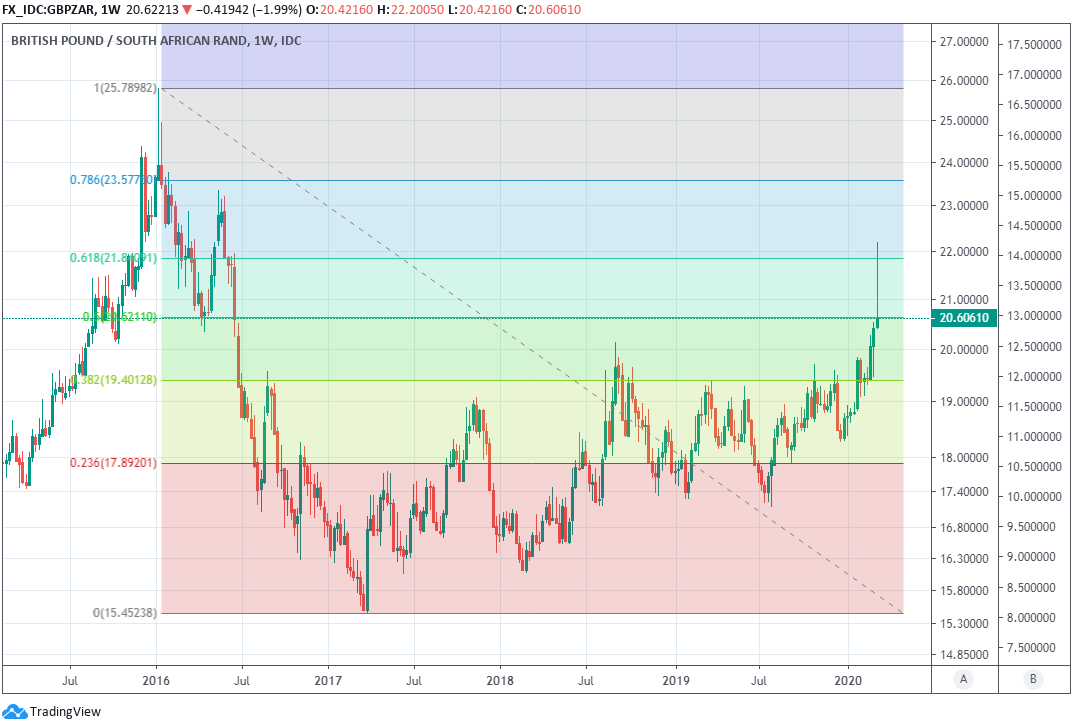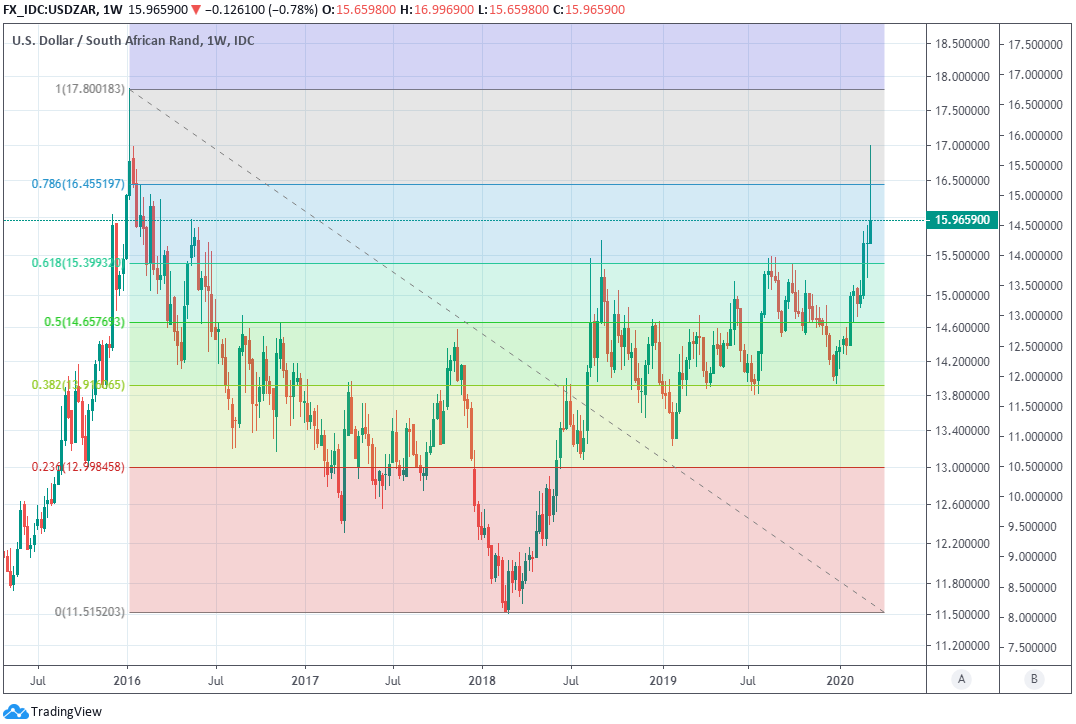South African Rand Loiters Near Multi-year Lows and Risks More Losses
- Written by: James Skinner
- ZAR steadies as global fiscal stimulus hopes mount.
- As U.S., UK, AU and NZ prepare stimulus packages.
- But SA economic challenges, rating risk still severe.
- SA has little room to maneuver on spending in crisis.
- GBP/ZAR and USD/ZAR still near to multi-year highs.
- GBP/ZAR eyes 50% retracement of Jan 16 downtrend.
- As USD/ZAR establishes itself above 15.40 resistance.

Image © Adobe Images
- GBP/ZAR Spot Rate: 20.62 down -1.69% today
- Indicative bank rates for transfers: 19.97-20.12
- Indicative broker rates for transfers: 20.39-20.51 >> find out more about this rate.
The Rand steadied near multi-year lows against the Pound and Dollar Tuesday as hopes of a global fiscal stimulus appeared to mount, but increased government spending in the world’s major economies might not be enough to save the South African currency from more losses in the weeks ahead.
South Africa’s Rand traded a fraction higher Tuesday as markets awaited President Donald Trump’s “very substantial relief” package for companies and households who’re bracing for a possible increase in coronavirus cases after four million test kits were delivered to states on Monday. Trump said American workers shouldn’t “miss a pay cheque” and that the airline and cruise industries could receive relief because the coronavirus is “not their fault.”
Trump is also said to be considering using the Federal Emergency Management Agency to get funding to companies and households whose businesses and jobs are threatened by the virus that’s now spread to well over half the world’s countries. FEMA funding would enable the White House to act quicker than if it needed to get spending and tax decisions through a divided congress.
“The rand has seen further recovery today, to R15.75/USD, R17.87/EUR and R20.55/GBP from R15.93/USD, R18.17/EUR and R20.83/GBP around midday yesterday,” says Annabel Bishop, chief economist at Investec. “Markets have also seen stabilisation today as they digest the stimulus suggestions of various countries and authorities to help deal with the impact of Covid-19. ”

Above: Pound-to-Rand rate shown at hourly intervals alongside USD/ZAR rate (blue line).
Once Trump’s 21:00 London time press conference is out of the way markets could turn their attention to the UK, Australia and New Zealand where national budgets or emergency spending statements are expected to be announced in the coming days, with the UK next on the list at 11:30 on Wednesday.
The prospect of G7 governments following in the footsteps of their central banks, who cut interest rates last week to support their economies as they each grapple with coronavirus outbreaks, helped to stem inflows into the bond market Tuesday while that and other factors lifted oil prices off Monday’s lows.
Even sickly stock markets saw a lesser degree of selling Tuesday but the Rand lacked the upward momentum to reclaim notable support levels lost to the Pound or Dollar on the charts previously.
“At the risk of sounding like a seasoned realist (I am an economist after all), the slight uplift in global bourses this morning could simply be a dead cat bounce as the spread of Covid-19 continues to undermine prospects for corporate earnings and provoke fears of a funding crisis. Lest we forget that the numbers are still increasing outside of China at breakneck speeds,” says Nema Ramkhelawan-Bhana, an economist at Rand Merchant Bank.

Above: Pound-to-Rand rate show at weekly intervals, breaking above 50% retracement of January 2016 downtrend.
The Rand appears to have lost support on the charts but still faces a toxic cocktail of headwinds that could keep it near record lows in the coming weeks, including the prospect of a domestic outbreak of coronavirus that SA can ill afford the cost of, in addition to further possible disruptions to major economies stemming from efforts to contain their own outbreaks of the viral pneumonia.
This is after Italy’s became the first democratic country to put in place nationwide restrictions on the movement of people Tuesday, barely a day after it announced the same restrictions for a quarter of its population in and around Lombardy helping to trigger the most ferocious stock market sell-off since the Eurozone debt crisis in the process. Italy has the largest outbreak outside of China and its economy was already in recession before then, although it will now faces extra damage from containment measures that will leave streets, bars, restaurants, cafes and potentially even offices empty. That could have implications for the entire European and global economies.
The Rand has a positive correlation with risk appetite so when investors fear for the global growth outlook and are selling risk assets as a result, the South African currency is normally one of the things being sold. And investors could be compelled to sell risk assets again if the spread of coronavirus gains further momentum outside of China or if other western governments flirt with ‘lockdown’ measures to contain their own outbreaks.
“The US government will make headlines today as policymakers look to fiscal stimulus to assist the rapid selloff in financial markets, while markets have already priced in yet another Federal Reserve rate cut, largely expected next week. A coordinated stimulus response by the G7 central banks is also being debated, following the failure of individual stimulus measures,” says Bianca Botes, a treasury partner at Peregrine Treasury Solutions. “We can expect the rand to continue in a broad range, while a break below R15.85 will affirm a move stronger for the local unit.”

Above: USD/ZAR rate show at weekly intervals, breaking above 61.8% retracement of January 2016 downtrend.
The Rand also risks seeing South Africa’s credit rating cut to ‘junk’ in an end of March Moody’s review after the 2020 budget left the debt-to-GDP ratio on a sharp upward trajectory. And that upward debt-to-gdp ratio leaves the government will very little, if any room for stimulus in the event that coronavirus does take hold in the domestic economy or if the looming global slowdown hampers the already-contracting domestic economy.
Another problem for the Rand is that Monday’s losses appear to have seen the Pound-to-Rand and USD/ZAR rates overcome notable resistance levels on the charts, denoting a loss of support for the Rand that has left the South African currency vulnerable to further declines in the coming days and weeks.
The Pound-to-Rand rate rate rose as high as 22.17 Monday after surging through the 20.62 level that coincides with the 50% retracement of the January 2016. And every daily close above that latter level would bring a weekly close above it a step closer, which might then signal to the market that further gains toward the 21.84 level and above are likely.
Meanwhile, the USD/ZAR rate has achieved a similar feat after breaking above the 15.40 level in early March and is now targeting a fresh challenge of the 16.45 threshold that would put it in touching distance of fresh record highs. The USD/ZAR rate already traded as high as 17.0 on Monday after breaking above the 61.8% retracement of its January 2016 downtrend last week, although it's since and for the time being dipped back below 16.




